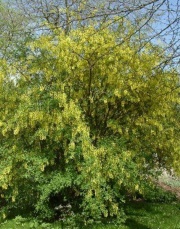Laburnum
Jump to navigation
Jump to search
Description
A small lilac-like tree with yellow flowers, Laburnum anagyroides, most often cultivated as an ornamental tree. Laburnum wood is brown with yellow streaks and has been used for inlays and as a substitute for ebony.
Synonyms and Related Terms
common laburnum (Laburnum anagyroides); alpine laburnum (Laburnum alpinum); Voss's laburnum (Laburnum watereri); golden chain tree; goldenchain; guldregn (Dan.); goldregen (Deut.); cytise (Fr.); Cytise faux ébénier (Fr.); Aubour(Fr.); goudenregen (Ned.); maggiociondolo (It.)
Risks
All parts of this plant are toxic; consumption may be fatal.
Physical and Chemical Properties
- Small tree to 5-7 m.
- Bark = smooth greenish brown; some splits occurring with age.
- Leaves = alternate trifoliate.
- Flower = bright yellow hanging clusters (10-30 cm long) occurring in early spring
- Fruit = flat pod in clusters, brown when ripe in early fall.
- Color= Heartwood ranges from an orangish brown to a darker violet brown, darkening with age. Sapwood is a pale yellow.
- Grain = usually straight with fine, even texture
Working Properties
- Generally easy to work.
- An excellent turning wood, and is also favored for carving as well.
- Endgrain slices of Laburnum are sometimes used in making a decorative “oyster veneer” pattern for use in furniture.
Resources and Citations
- The Wood Database: Laburnum
- Schoch, W., Heller, I., Schweingruber, F.H., Kienast, F., 2004:Wood anatomy of central European Species: Golden Chain,Laburnum anagyroides Med.
- George Savage, Art and Antique Restorer's Handbook, Rockliff Publishing Corp, London, 1954
- Virginia Tech Dendrology website at www.fw.vt.edu/dendro/dendrology/main.htm (accessed Oct. 8, 2005)
- Wikipedia: http://en.wikipedia.org/wiki/Laburnum (Accessed Oct. 8, 2005)
- The American Heritage Dictionary or Encarta, via Microsoft Bookshelf 98, Microsoft Corp., 1998

